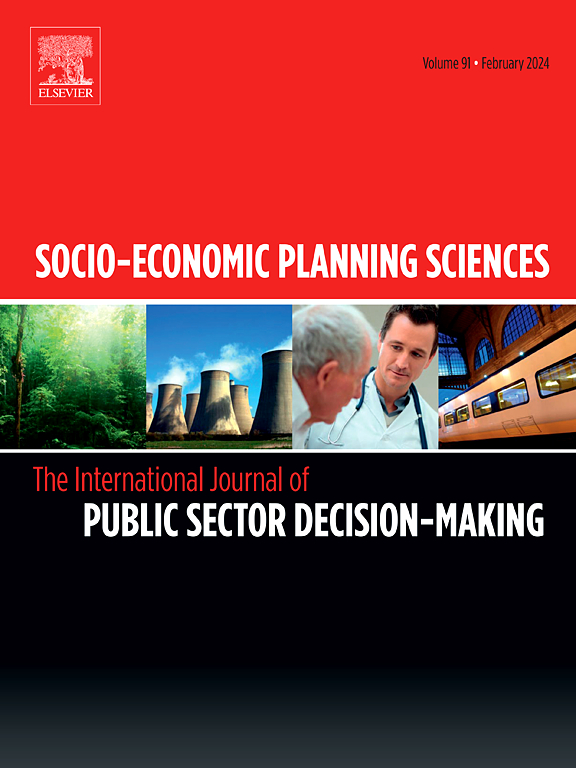研究生扩招中培养效率优化:一种新的并行网络DEA分配模型
IF 5.4
2区 经济学
Q1 ECONOMICS
引用次数: 0
摘要
在中国研究生招生规模不断扩大的背景下,确保研究生教育质量已成为全社会长期关注的焦点。目前,我国高校之间和高校内部研究生招生名额分配模式尚未形成有效的竞争机制,难以体现质量导向,提高培养效率。为此,提出了一种基于共享投资的并行网络数据包络分析(DEA)招生配额分配模型,以实现效率和公平。以上海某高校专业学位研究生招生名额分配为例进行实证分析。研究表明:(1)现有的分配方案只遵循单一的高平均原则,忽略了分配效率。通过优化,分配效率由0.76提高到1。(2)主观阶段权重系数γ1 = 0.9时,分配方案的基尼系数最低,为效率优先条件下的最优分配方案。(3)当主观效率阶段系数和主观效率阶段内投入导向权重系数分别变化11%和40%时,试验组与对照组在分配结果上无显著差异(P >;0.05), Pearson相关系数(R2)为0.96。因此,该分配模型具有良好的稳定性,可应用于不同院校和其他类型研究生的招生名额分配。本文章由计算机程序翻译,如有差异,请以英文原文为准。
Optimizing training efficiency amid postgraduate enrollment expansion: A new parallel network DEA allocation model
Against the backdrop of the continuous expansion of postgraduate enrollment in China, ensuring the quality of postgraduate education has become a long-term focus of concern for the entire society. Currently, the allocation model of postgraduate enrollment quotas among Chinese universities and within universities has not formed an effective competitive mechanism, making it difficult to reflect quality orientation and improve training efficiency. Therefore, a new parallel network data envelopment analysis (DEA) enrollment quotas allocation model based on shared investment is proposed to achieve efficiency and fairness. An empirical analysis is conducted using the allocation of enrollment quotas for professional degree postgraduates at a university in Shanghai as an example. The study shows that (1) the existing allocation schemes only follow a single high average principle, which neglects allocation efficiency. Through optimization, the allocation efficiency has been improved from 0.76 to 1. (2) When the subjective stage weight coefficient = 0.9, the Gini coefficient of the allocation scheme is the lowest, which is the optimal allocation scheme under the condition of efficiency priority. (3) When the coefficient of the subjective efficiency stage and the input-oriented weight coefficient within the subjective efficiency stage change by 11 % and 40 %, respectively, there is no significant difference between the test and control groups in the allocation results (P > 0.05), and the Pearson correlation coefficient (R2) is 0.96. Therefore, this allocation model demonstrates good stability and can be applied to the allocation of enrollment quotas among different universities and other types of postgraduates.
求助全文
通过发布文献求助,成功后即可免费获取论文全文。
去求助
来源期刊

Socio-economic Planning Sciences
OPERATIONS RESEARCH & MANAGEMENT SCIENCE-
CiteScore
9.40
自引率
13.10%
发文量
294
审稿时长
58 days
期刊介绍:
Studies directed toward the more effective utilization of existing resources, e.g. mathematical programming models of health care delivery systems with relevance to more effective program design; systems analysis of fire outbreaks and its relevance to the location of fire stations; statistical analysis of the efficiency of a developing country economy or industry.
Studies relating to the interaction of various segments of society and technology, e.g. the effects of government health policies on the utilization and design of hospital facilities; the relationship between housing density and the demands on public transportation or other service facilities: patterns and implications of urban development and air or water pollution.
Studies devoted to the anticipations of and response to future needs for social, health and other human services, e.g. the relationship between industrial growth and the development of educational resources in affected areas; investigation of future demands for material and child health resources in a developing country; design of effective recycling in an urban setting.
 求助内容:
求助内容: 应助结果提醒方式:
应助结果提醒方式:


